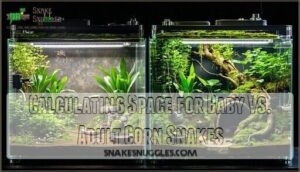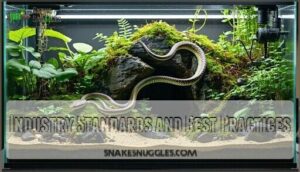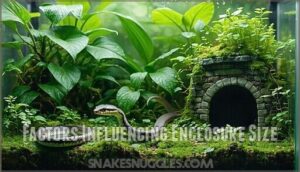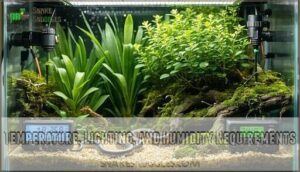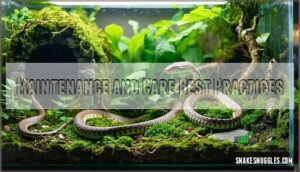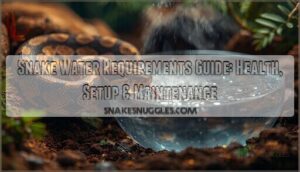This site is supported by our readers. We may earn a commission, at no cost to you, if you purchase through links.
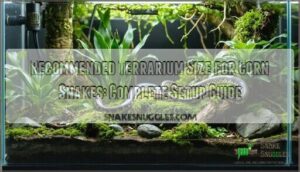
For juvenile snakes, you can start smaller but plan ahead since they’ll outgrow it quickly. The general rule is 0.7 times your snake’s length by 0.5 times its length for floor space.
Spacious enclosures aren’t just nice to have—they’re essential for your snake’s wellbeing. When corn snakes have room to roam, they stay more active and show off their natural curiosity.
Of course, square footage alone won’t make a great home.
Table Of Contents
- Key Takeaways
- Recommended Terrarium Size for Corn Snakes
- Factors Influencing Enclosure Size
- Setting Up a Corn Snake Habitat
- Temperature, Lighting, and Humidity Requirements
- Maintenance and Care Best Practices
- Frequently Asked Questions (FAQs)
- How often should the substrate in a corn snake’s terrarium be changed?
- Can corn snakes be housed with other reptiles or animals?
- How often should corn snakes be handled for socialization purposes?
- Can corn snakes outgrow their terrariums quickly?
- What terrarium brands work best for corn snakes?
- How much does a proper corn snake setup cost?
- Do corn snakes need different enclosures when shedding?
- Can multiple corn snakes share the same terrarium?
- Conclusion
Key Takeaways
- You’ll need a minimum 48" x 24" x 24" terrarium for adult corn snakes, but bigger enclosures improve your snake’s physical and mental health by allowing natural behaviors like exploring and climbing.
- Plan ahead for growth since juvenile snakes outgrow smaller enclosures quickly – most reach adult size around 18 months, so investing in proper adult dimensions from the start saves money and stress.
- Use the length-based formula of 0.7 times your snake’s body length by 0.5 times its length for minimum floor space, but remember this is just the baseline for adequate housing.
- Proper enclosure size directly impacts your snake’s wellbeing – cramped spaces cause muscle deterioration, increased stress behaviors, and reduced activity levels that you can easily prevent with adequate housing.
Recommended Terrarium Size for Corn Snakes
A properly sized terrarium is essential for your corn snake’s health and comfort as they grow to their adult length.
The minimum recommended size is 48″L x 24″W x 24″H for most adult corn snakes, but larger enclosures provide even better results for their physical and mental well-being.
Minimum Enclosure Dimensions Based on Snake Length
Setting up your corn snake’s home comes down to a simple length-based formula. You’ll want the minimum enclosure to measure 0.7 times your snake’s length by 0.5 times its length.
For a 4-foot corn snake, that means 2.8 by 2 feet of floor space. This terrarium volume calculation ensures your snake has enough room to stretch out comfortably without feeling cramped in tight quarters.
Calculating Space for Baby Vs. Adult Corn Snakes
Baby corn snakes start small but grow fast. A hatchling enclosure can be 20-gallon long, but you’ll need long-term planning for adult dimensions.
Juvenile growth means upgrading terrarium size as your snake reaches 2-3 feet. Adult corn snakes need that full 48"x24"x24" setup.
Space adjustment happens around 18 months when most reach adult size.
Why Bigger Enclosures Benefit Corn Snakes
Larger enclosures help your corn snake reach its full potential. With more room, they’ll develop improved muscle tone through natural movement and climbing.
Enhanced exploration reduces stress while encouraging natural behaviors like hunting patterns. A spacious snake habitat allows for better enrichment opportunities, from hiding spots to climbing branches.
Think of enclosure size as your snake’s personal gym – the bigger the space, the healthier and happier your reptile care becomes.
Industry Standards and Best Practices
Most reptile vets, including those from the Association of Reptilian and Amphibian Veterinarians, say adult corn snakes need at least a 40-gallon tank.
The standard setup that works well is 4 feet long, 2 feet wide, and 2 feet tall, with a tight-fitting lid and proper airflow.
European reptile legislation emphasizes space for natural behaviors. A larger enclosure helps encourage essential corn snake behaviors, such as climbing and burrowing.
Quality enclosure materials from reputable manufacturers reinforce breeder responsibility and ethical sourcing practices.
Factors Influencing Enclosure Size
You can’t just guess your corn snake’s adult size when planning their forever home. Understanding your snake’s genetics, sex, and growth patterns helps you choose the right enclosure from the start, preventing costly upgrades and guaranteeing your pet’s long-term health and happiness.
Predicting Adult Size From Genetics
You can predict your corn snake’s adult size by looking at its parents’ genetics. Parental Size Impact shows clear heritability estimates – males commonly match their father’s length while females follow their mother’s growth pattern. Understanding genetic potential helps you choose the right terrarium size from day one. As adults, corn snakes can reach a length of 3 to 5.5 feet, so plan accordingly.
Here’s what affects your snake’s final dimensions:
- Lineage and Morphology – Some morphs like scaleless varieties carry size-affecting mutations
- Growth Rate Factors – Genetic markers influence how quickly juveniles reach adult corn snake length
- Wild Population Origins – Southern lineages often produce larger specimens due to underlying genetics
- Breeding Selection – Targeted breeding for size creates predictable snake enclosure size requirements
Ask your breeder about the parents’ measurements. This gives you the most reliable prediction for planning your corn snake habitat requirements and choosing appropriate terrarium size for long-term housing.
Male Vs. Female Growth Patterns
Understanding sexual dimorphism helps you plan your corn snake’s forever home. Males usually reach 3-4 feet at mature size, while females grow larger at 4-5 feet.
This growth rate difference means genetic influence from breeding impact matters when calculating your adult corn snakes’ enclosure size needs for their terrarium size requirements.
Impact of Enclosure Size on Snake Health and Behavior
Your snake’s enclosure size matters more than you might think. When snakes can’t stretch out properly, it shows up fast in their behavior and health.
- Snake health deteriorates when enclosures are shorter than body length—54.7% of snakes can’t stretch fully
- Behavioral enrichment decreases in small spaces, leading to more escape attempts and stress behaviors
- Muscle development suffers without room for natural movement and climbing opportunities
- Activity levels drop inappropriately when snakes lack adequate space for exploration
- Overall well-being improves considerably when environmental stresses from poor housing are eliminated
Setting Up a Corn Snake Habitat
Now that you’ve picked the right terrarium size, it’s time to set up a habitat that’ll keep your corn snake happy and stress-free.
Setting up the enclosure correctly from the start prevents common health issues and reduces stress for both you and your snake.
Essential Features for Comfort and Safety
Your corn snake needs specific features to feel safe and comfortable. Two hides with a deep substrate for burrowing will make your snake feel much safer and more comfortable.
Make sure the water bowl is accessible and easy to remove, but minimize open space, as corn snakes are most comfortable when they’ve plenty of climbing and hiding opportunities available. Choose something that won’t tip over in the setup, but is deep and wide enough for proper water access.
Importance of Secure Lids and Escape Prevention
You’ll want a secure locking lid on your snake enclosure—corn snakes are escape artists who’ll exploit any weakness. Choose heavy-duty materials like reinforced mesh or solid tops with reliable locking mechanisms. DIY solutions work, but commercial vivarium locks offer better security.
Remember, escape consequences include injury, death, or losing your pet forever. Proper safe snake housing practices start with preventing escapes.
Substrate Options, Including Bioactive Setups
Choosing the right substrate creates a foundation for your snake’s comfort. Aspen bedding substrate works well for basic setups, while a bioactive terrarium setup offers long-term benefits.
A proper drainage layer prevents soggy conditions. Mix coconut fiber with organic topsoil for an ideal substrate depth of 3-4 inches.
For a bioactive setup, add isopod introduction and hardy plant choices. This cage bedding approach encourages natural burrowing behaviors and maintains proper humidity levels.
Providing Climbing Structures and Enrichment
Beyond basic housing, your corn snake craves vertical adventures. Install sturdy branches, cork bark pieces, and artificial vines to encourage natural climbing behaviors. These cage accessories provide mental stimulation while supporting muscle development.
DIY options like PVC pipes work well for budget-friendly snake habitat design. Focus on climbing safety by securing all cage furnishings properly—wobbly structures stress snakes.
Smart reptile enclosure setup includes varied textures and heights, transforming basic snake enclosure design into enriching environments that promote natural behaviors and overall wellness.
Temperature, Lighting, and Humidity Requirements
Temperature, lighting, and humidity work together to create the right environment for your corn snake—just like mimicking what they’d experience in the wild.
Getting all three elements right is what makes your snake feel at home and stay healthy.
Creating a Temperature Gradient
Your snake needs a proper temperature gradient to stay healthy and digest food properly. Think of it like creating different climate zones in one enclosure.
Here’s how to set up thermal zones effectively:
- Basking spot temp: 88-92°F using overhead heat sources
- Warm side: 78-82°F ambient air temperature
- Cool side temp: 75-78°F for temperature regulation
- Thermostat control: Digital controllers prevent overheating
Use heating requirements like under-tank heaters and ceramic emitters as heat source types. Make seasonal adjustments during winter months.
Proper Lighting for Corn Snakes
While heat lamps handle temperatures, proper lighting aids your corn snake’s day-night cycle and overall wellness. UVB benefits include improved calcium absorption and natural behaviors. Reptile lighting requirements vary, but a 12-hour lighting schedule works well. Natural light from windows helps, though dedicated UVB bulbs provide consistent UV lighting.
Here’s your lighting setup guide:
Snake heating and lighting work together—consistent schedules keep your pet healthy and stress-free.
Monitoring and Maintaining Ideal Humidity
Humidity monitoring requires digital hygrometers placed throughout your corn snake’s enclosure. Maintaining 40-60% humidity prevents shedding issues and aids proper hydration methods. Here’s your humidity control checklist:
- Place hygrometers on both warm and cool sides for accurate temperature regulation
- Use misting techniques with distilled water to raise levels safely
- Choose moisture-retentive substrate like cypress mulch for stability
- Increase ventilation immediately if you notice mold prevention concerns
Regular monitoring prevents environmental stresses.
Maintenance and Care Best Practices
Keeping your corn snake healthy means staying on top of terrarium cleaning, feeding your snake regularly, and watching for any health changes.
These routine care practices prevent health issues and help your snake stay comfortable in its properly sized enclosure.
Cleaning and Disinfecting The Enclosure
Keep your snake enclosure spotless to prevent illness and control odors. Clean waste immediately and perform deep cleaning monthly. Use reptile-safe disinfectants on all surfaces, replace substrate regularly, and maintain proper humidity control throughout the process.
| Cleaning Task | Frequency | Method |
|---|---|---|
| Spot cleaning waste | Immediately | Remove with tongs, disinfect area |
| Water bowl cleaning | Weekly | Scrub with reptile-safe soap |
| Deep enclosure cleaning | Monthly | Remove snake, disinfect all surfaces |
| Substrate replacement | Monthly | Replace completely, clean underneath |
| Equipment sanitizing | Monthly | Wipe down hides, decorations |
Feeding Guidelines and Water Provision
Proper nutrition forms the foundation of corn snake health. You’ll feed adult corn snakes every 10-14 days, while juveniles eat weekly. Choose prey that’s roughly as wide as your snake’s thickest part.
- Feeding Frequency: Adults need meals every 10-14 days, juveniles weekly
- Prey Size: Select prekilled food matching your snake’s widest body section
- Water Source: Provide fresh water in a sturdy bowl, changed during shedding
Handling, Socialization, and Monitoring Health
Regular handling builds trust between you and your corn snake. Start with short sessions twice weekly, watching for temperament changes or stress signs.
During shedding, avoid handling as their skin becomes sensitive. Monitor for respiratory issues like mouth breathing or wheezing.
Quarantine protocols matter if introducing new captive snakes. Environmental stresses affect snake health, so maintain consistent care routines for animal welfare.
Frequently Asked Questions (FAQs)
How often should the substrate in a corn snake’s terrarium be changed?
Like tidying your bedroom regularly, substrate maintenance follows a simple pattern. You’ll want to replace all substrate every 3-4 months , but spot-clean waste immediately to keep your snake’s home fresh and healthy.
Can corn snakes be housed with other reptiles or animals?
You shouldn’t house corn snakes with other reptiles or animals. They’re solitary by nature and can stress, compete for resources, or potentially harm tankmates through disease transmission or aggression.
How often should corn snakes be handled for socialization purposes?
You’ll want to handle your corn snake 2-3 times per week for about 10-15 minutes each session. This frequency helps them stay comfortable with human contact without causing stress.
Can corn snakes outgrow their terrariums quickly?
Corn snakes grow surprisingly slowly – reaching just 2-3 feet by year two. You won’t need frequent terrarium upgrades since they’ll comfortably use their adult-sized enclosure throughout their 20+ year lifespan.
What terrarium brands work best for corn snakes?
Popular brands like Exo Terra, Zoo Med, and Vision Products offer excellent terrarium options.
Vision Cages provides escape-proof construction, while Exo Terra features beautiful glass designs and Zoo Med’s ReptiHabitat terrariums work well for corn snakes.
How much does a proper corn snake setup cost?
Breaking the bank isn’t necessary for your corn snake’s first home. You’ll spend between $250 and $600 on initial setup costs for a proper terrarium, heating, substrate, and essential equipment.
Do corn snakes need different enclosures when shedding?
You don’t need different enclosures when your corn snake is shedding. Simply increase humidity to 60-70% during the shed cycle by misting the enclosure or adding a humid hide box.
Can multiple corn snakes share the same terrarium?
Think of cohabitation as crowding two strangers in a phone booth—it’s uncomfortable and stress-inducing. You shouldn’t house multiple corn snakes together. They’re solitary creatures, and sharing space causes stress, illness, and potential injury.
Conclusion
Studies show that snakes in appropriately sized enclosures display 40% more natural behaviors than those in cramped spaces. Getting the recommended terrarium size for corn snakes right from the start saves you money and stress later.
Properly sized enclosures allow corn snakes to display 40% more natural behaviors, making the investment in adequate space essential for their wellbeing
You’ll avoid upgrading costs and give your snake the space it needs to thrive. Remember, your corn snake will spend its entire life in this enclosure, so investing in proper dimensions creates a healthier, more active pet that’s genuinely enjoyable to observe.


